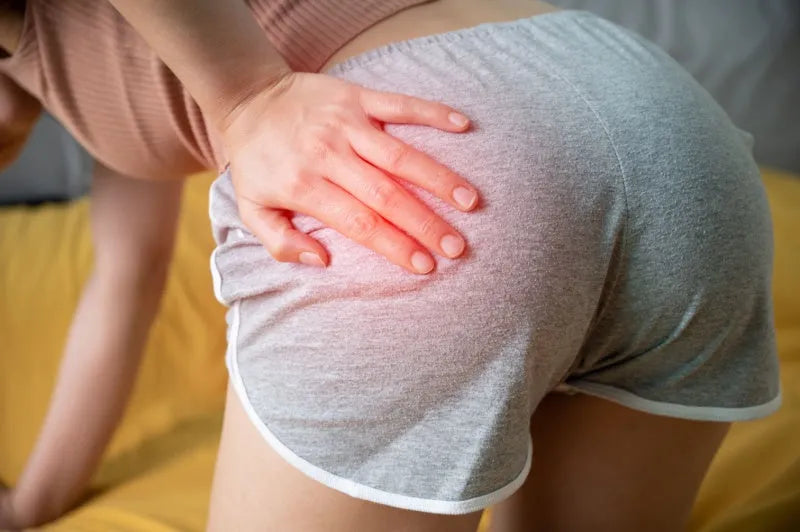
A Pain in the ... Hips!
Gluteal tendinopathy, often referred to as "lateral hip pain" or "greater trochanteric pain syndrome," is a condition that affects the tendons of the gluteal muscles, primarily the gluteus medius and gluteus minimus. These muscles play a crucial role in stabilizing your hips and pelvis during movement. When the tendons in this area become irritated, inflamed, or degenerate, it leads to pain and discomfort around the hip, often impacting daily activities like walking, standing, and climbing stairs.
What Causes Gluteal Tendinopathy?
Several factors contribute to the development of gluteal tendinopathy, including:

Overuse or Repetitive Strain: Activities that involve repetitive hip movement, such as running, walking long distances, or cycling, can place undue stress on the gluteal tendons, leading to microtears and degeneration over time.
Muscle Weakness or Imbalance: Weakness in the gluteal muscles can increase the load on the tendons, leading to irritation. Similarly, muscle imbalances, where one side of the body is stronger or more flexible than the other, can create asymmetrical strain on the tendons.
Age-Related Degeneration: As we age, tendons naturally lose some of their elasticity and strength. Gluteal tendinopathy is more common in individuals over the age of 40, especially postmenopausal women, due to changes in tendon structure and hormonal fluctuations.

Poor Biomechanics or Posture: Faulty movement patterns, such as hip instability, improper gait, or poor posture, can place excess stress on the tendons. Issues like flat feet or tight hip flexors can also contribute to tendon overload.
Direct Trauma: Though less common, a fall or impact to the side of the hip can cause direct injury to the gluteal tendons, leading to tendinopathy.Symptoms of Gluteal Tendinopathy
The hallmark symptom of gluteal tendinopathy is pain around the lateral (outer) hip, which may worsen with activity or pressure. Common signs include:

- Aching or sharp pain on the outside of the hip, especially when lying on the affected side
- Pain that worsens with walking, climbing stairs, or standing from a seated position
- Tenderness over the greater trochanter (the bony prominence on the side of the hip)
- Stiffness and difficulty with hip movement, especially after prolonged inactivity
- Pain that radiates down the outer thigh, but rarely past the knee
How to Treat Gluteal Tendinopathy

Treating gluteal tendinopathy typically involves a combination of self-care measures, physical therapy, and medical interventions. Here’s a breakdown of effective treatment options:
Rest and Activity Modification- Avoid activities that exacerbate the pain, such as prolonged walking, running, or standing. Switching to low-impact exercises like swimming or cycling can reduce stress on the tendons while maintaining cardiovascular fitness.
- Applying ice to the affected area can help reduce inflammation, especially in the acute phase. As the pain subsides, heat therapy can promote blood flow and healing.

- Strengthening the gluteal muscles is key to treating tendinopathy. A physical therapist can guide you through exercises that target hip stabilizers, improve flexibility, and correct muscle imbalances. Common exercises may include glute bridges, clamshells, and hip abduction.
- Gentle stretches for the hips and lower back can help relieve tension around the tendons. Stretching the IT band (iliotibial band) and hip flexors can also be beneficial for reducing excess strain on the gluteal muscles.
Discover Natural Joint from Greek Island Labs

- Description: Natural Joint from Greek Island Labs combines 37 natural vegetarian ingredients inspired by the Mediterranean diet. It’s designed to support joint health without affecting blood sugar levels, unlike some other supplements.
- Benefits: Many users report noticeable improvements in joint comfort and mobility.
Usage Instructions:
- Dosage: For severe pain, take one capsule twice daily with a full glass of water—once in the morning and once in the afternoon. After 14 days, adjust to one capsule per day as needed.
- Maintenance: For mild pain or prevention, one capsule daily is often sufficient.
Corticosteroid Injections
- If conservative treatments are not effective, a corticosteroid injection may be recommended to reduce inflammation and provide temporary pain relief. While these injections can be helpful, they are generally considered a short-term solution.
Shockwave Therapy

- This non-invasive treatment uses sound waves to stimulate healing in the affected tendons. Studies have shown that shockwave therapy can be effective in reducing pain and promoting tendon regeneration.
Surgical Intervention
- In rare cases where conservative treatments fail, surgery may be necessary to repair the damaged tendon. This is usually only considered after several months of unsuccessful therapy.
Preventing Gluteal Tendinopathy

To reduce your risk of developing gluteal tendinopathy, consider the following tips:
- Strengthen your hips and glutes: Regularly performing exercises that target the gluteal muscles can help prevent weakness and imbalance.
- Maintain good posture: Avoid slouching or standing with one hip jutting out, as poor posture can increase strain on the tendons.
- Wear proper footwear: Supportive shoes that align your feet properly can reduce the risk of poor biomechanics contributing to tendon overload.
- Stretch regularly: Incorporate hip and lower body stretches into your routine, especially if you engage in activities that involve repetitive hip movements.
Final Thoughts
Gluteal tendinopathy can be a painful and limiting condition, but with the right approach to treatment and prevention, most people can recover fully and return to their normal activities. If you're experiencing persistent hip pain, it’s essential to consult a healthcare professional for an accurate diagnosis and tailored treatment plan.
By addressing the underlying causes of tendon overload, strengthening the gluteal muscles, and making simple lifestyle modifications, you can alleviate symptoms and get back to moving comfortably!
